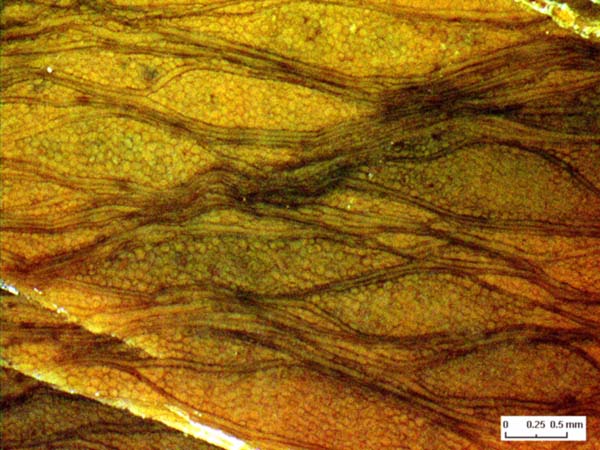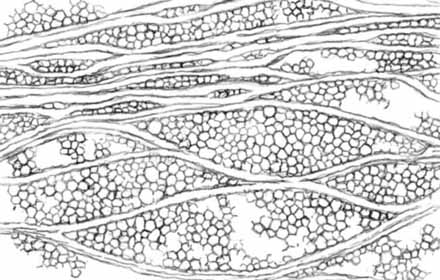How the largest known anatomically preserved
calamite was discovered in Chemnitz
Many a story could be told about how a combination of lucky incidences
led to an unexpected discovery.
The story of the big calamite [1] is
instructive with respect to both the fossil and the people involved.
The steps leading to the publication had been reported by R.
Kretzschmar
on his website, from which several
text passages are quoted here:
Galtier's Pitus in the Rotliegend of Saxony ?
In 2002,
U. Dernbach
issued
his latest edition, with a contribution
by J. Galtier
[2] on
a large fossil tree from the
Carboniferous of
Scotland. The tissue structure of the wood shown there is in some way
similar to that of small samples of petrified wood recently found at
the Kleinnaundorf /Burgk site, as noticed by H.-J. Weiss,
who called it
"the wood with the biggest pith rays in the Döhlen basin". The
similarity becomes evident when comparing the pictures below with that
of Pitus
primaeva
in the above-mentioned book. [End of
quotation]
 Silicified
wood resembling Pitus [2] and Arthropitys [1],
tangential
section with exceptionally wide secondary pith rays, seen here
as cross-sections. Lower Permian, Döhlen basin, Saxony.
Photograph:
Hagen Sahm,
Dresden.
Silicified
wood resembling Pitus [2] and Arthropitys [1],
tangential
section with exceptionally wide secondary pith rays, seen here
as cross-sections. Lower Permian, Döhlen basin, Saxony.
Photograph:
Hagen Sahm,
Dresden.
Width of the pictures 5mm
(left) and 3.5mm
(below).
Drawing of
another part of the same sample.

Sample: found in 2000 at the
type locality of Scolecopteris
between Kleinnaundorf and Burgk, kept in the own collection under the
label Bu7/20.1.
The
present sample is a 9cm wide fragment of a rounded boulder, the larger
part of which was apparently not recovered from the excavated matter on
the construction site in the Döhlen basin. The divergence of the pith
rays on the available small part of the cross-section seems to indicate
a stem diameter of about 50cm (which may be
smaller if a slight deformation of the cross-section into elliptical
shape is taken into account). The size of the pith ray cells is about
the
same as in [1].
[Quotation continued:] A
small fragment of
petrified wood found by the present author [R. Kretzschmar]
in
excavated matter from a construction site at Chemnitz-Hilbersdorf,
Zeiss-Str. 14, showed the same features. Soon it became apparent that
the
fragment most probably belonged to a rather big tree trunk part
recovered by fossil collectors in cooperation with the Museum für
Naturkunde Chemnitz in 2002. [End of quotation]
After referring to several facts from the calamite literature, Kretzschmar arrived
at the following conclusion, with a supplement added
later:
[Quotation continued:] The
above-mentioned finds resembling Pitus wood
are worth a detailed inspection since, in our opinion, they are clearly
distinguished from the more “normal” Dadoxylon-type wood
varieties.
This might provide an opportunity to disclose the nature of the
mysterious Pitus
tree.
Supplement
The subject has taken
an unexpected turn: When R. Rössler
and J.
Galtier
inspected the large trunk part ... on the occasion of
a taphonomy workshop on Nov. 8th/9th, 2003, they discovered
wood wedges with the typical carinal voids only found in calamites and
horsetails, and even a tiny central pith with cells preserved. Its
diameter of about 50cm makes this trunk the largest well-preserved
calamite ever seen. It will be scientifically investigated soon.
So it has turned out
that the suspicion aroused by the peculiar wood
structure of the splinter that the big trunk is something special has
come true, although in another way than expected.
Something has been
found out but one question still lingers around: Do
the big pith rays found in Saxony all belong to the giant calamite or
is there Pitus among them after all ? [End
of quotation]
The latter question concerning wood with wide pith rays will probably
not be answered soon. A related contribution will
be
presented later on the present website.
The big chunk is pictured in
[3]
in-situ and after cutting.
The big calamite is not only interesting in itself but also
reveals
something about the relations between people engaged in palaeobotany:
In the publication [1], R. Rössler
acknowledges the help of lots of
people, even mentioning the municipal firefighters. He does not
mention R. Krettzschmar,
who
provided the decisive information
leading to the discovery. If Kretzschmar
had not inspected
the excavated matter after the tree trunk had been removed from the
pit, if he had not found and closely looked at a small piece and
guessed it might belong to the big one (which is not trivial with more
small pieces of petrified wood lying around), and if he had not
compared it with other
uncommon wood types from the literature, the big calamite would have
been stored away, misinterpreted as "dull" Dadoxylon since
nobody had
expected a calamite of this size and preservation, and it would not
have been shown to Galtier
for close inspection. The story of the steps towards the discovery from
which the above quotations are taken had to be deleted on
www.kieseltorf.de in 2011 as if to erase it from memory so that the
impression develops that the discovery was made by Rössler
alone.
H.-J.
Weiss
2012
[1] R. Rössler,
R. Noll:
Sphenopsids of the Permian I: The largest
known anatomically preserved calamite, an exceptional find
from the petrified forest of Germany.
Rev. Palaeobot. Palyn. 140(2006), 145-62.
[2] J. Galtier:
Pitus, a
giant tree from Early Carboniferous. in: U. Dernbach,
W.D. Tidwell:
Secrets of Petrified Plants, D'ORO 2002.
[3] R. Rössler:
Veröff.
Museum für Naturkunde Chemnitz 26(2003),
(pictures on the inside of the cover).
|

|
 15 15 |

 15
15 Silicified
wood resembling Pitus [2] and Arthropitys [1],
tangential
section with exceptionally wide secondary pith rays, seen here
as cross-sections. Lower Permian, Döhlen basin, Saxony.
Photograph:
Hagen Sahm,
Dresden.
Silicified
wood resembling Pitus [2] and Arthropitys [1],
tangential
section with exceptionally wide secondary pith rays, seen here
as cross-sections. Lower Permian, Döhlen basin, Saxony.
Photograph:
Hagen Sahm,
Dresden.

 15
15